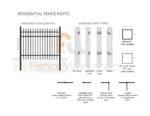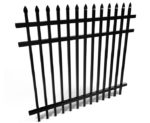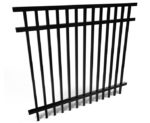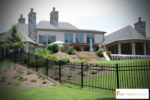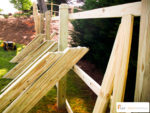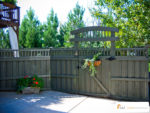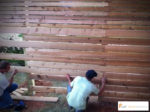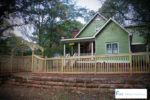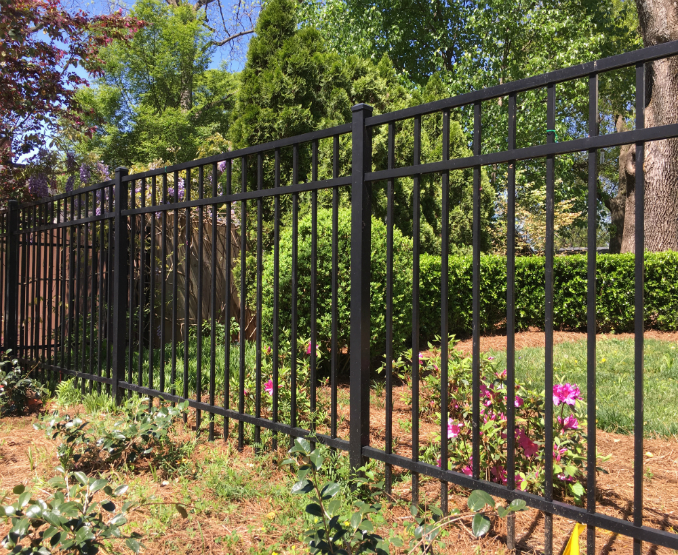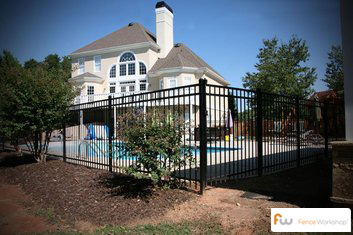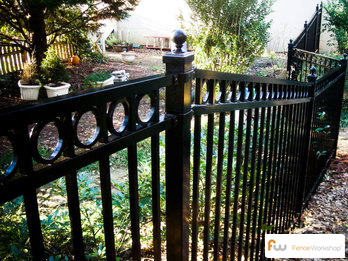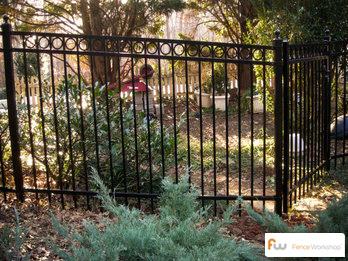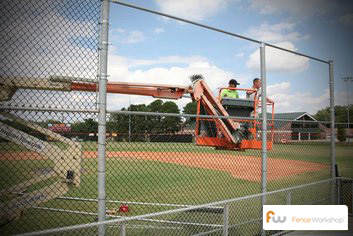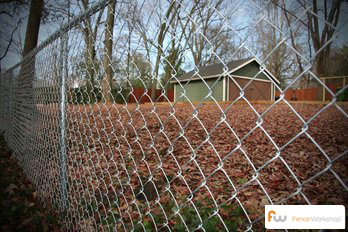Douglas County, GA Fence Building Codes & Permits
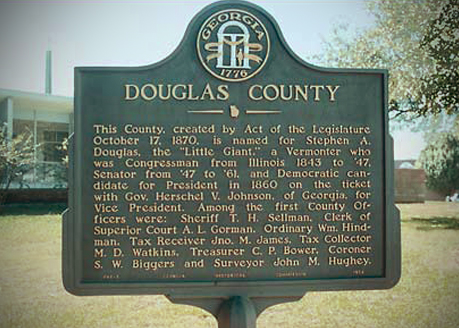 Douglas County does not always require a building permit when erecting a fence. A permit is always required if the site is located within “Conservation, Historic, Landmark, SPI districts or other districts requiring a Special Administrative Permit.
Douglas County does not always require a building permit when erecting a fence. A permit is always required if the site is located within “Conservation, Historic, Landmark, SPI districts or other districts requiring a Special Administrative Permit.
Fences and walls which conform to the provisions stated herein shall be permitted by the Department of Environment and Community Development. Fences erected for agricultural purposes in the AG-1 District shall be exempt from permit requirements.
Easements: No structure with the exception of fences may be located in, or otherwise obstruct any easement. Fences shall be permitted within easements subject to the receipt of written permission from the easement holder. Approval of the Zoning Administrator and applicable County Department shall be required for all fences proposed for placement in easements which are held by Douglas County.
Douglas County Fence and Wall Standards
Walls or fences shall be permitted in any zoning district and are not subject to setback requirements of this resolution, except that in a residential zoning district:
(1) A structure of wire, wood, stone or other materials, including invisible fencing, which is of sufficient height and strength to act as a barrier against the passage of the animal it is intended to enclose.
(1 A) A fence does not include an “invisible fence” if the fence is:
(1 b) Ineffective for any animal that has learned it can cross the fence line;
(1 e) An invisible fence is not an acceptable means of control for an animal that is classified as vicious, dangerous, potentially dangerous, or is in estrus/heat.
(2) Opaque fence: A fence through which one cannot see, constructed of uniform wood boards, plywood panels, chain link fence with vinyl slats or such other uniform material approved by the office of planning and zoning.
(3) Each outdoor flea market shall have placed on the portion of the property fronting on public roads an opaque fence at least eight (8) feet high, and on the remaining sides of the property a natural buffer area, hedge or shrubs, approved by the office of planning and zoning, or an opaque fence at least eight (8) feet high.
(4) An owner of a domesticated animal, whether vaccinated or not vaccinated, shall confine such domesticated animal within an adequate fence or enclosure or within a house, garage or other building to prevent the animal from running at large. No animal shall be tied or tethered as a permanent measure of restraint. No animal shall be left unattended on a chain, lead, runner, cable, rope, leash or similar tethering device.
(5) Material change in appearance. A change that will affect either the exterior architectural or environmental features of a historic property or any building, structure, site, object, or landscape feature within a historic district, such as: The erection, alteration, restoration or removal of any buildings or other structure within a historic property or district, including walls, fences, steps and pavements, or other appurtenant features.
(6) Pools must be enclosed by a fence or wall at least 4 feet in height with a self locking gate.
(7) Fences and freestanding walls, subject to the setback and height restrictions in the Lot and Building Standards Article of this Code (but no fence shall contain any barbed wire unless used to confine one or more horses or similar animals and no wooden fences are allowed except on an individual single-family lot as an accessory to a single-family home). (Amended 1/06/2009 – TXT2009-01, § 5)
(8) The owner of a private use heliport shall erect a safety barrier around the peripheral area surrounding the takeoff and landing area. The safety barrier shall be a fence, wall or hedge no less than three feet in height and fully enclosed with a self-locking gate.
(9) Any multi-family housing, commercial, office, wholesale, distribution, storage and industrial use within the Quality Growth Development (O-QGD) district, in addition to meeting all requirements and standards of this Development Code and of the district within which it is located, shall also comply with the minimum standards and restrictions of this Section.
(9-5 a) Decorative fences & walls: Any fences or walls not otherwise required for screening under this Subsection shall be of imitation-wood vinyl, stone, decorative iron, stucco on block, or decorative block. If located along a street, these fences or walls shall comply with the requirements for street-side screening in the Landscaping, Buffers and Tree Protection Article of this Development Code.
(9-5 b) Chain link, unfinished concrete or cinderblock, plastic or fiberglass, barbed or razor wire, and wood fences are prohibited for any purpose. Paint shall not be considered a finish material. However, a security fence may use the above prohibited materials if located inside an approved screening fence, wall, or other screening element as defined in Sec. 804 (c)(1)b.
Fences & Walls Cont.
(Revised September 2009) The Zoning Resolution (Section 700) and the Property Maintenance Ordinance (Section 14-301) contain requirements about the location, height, material, and maintenance of fences and walls on residential lots. In addition, the Development Regulations (Subsection 7.4.6) contain restrictions about the construction of fences and walls in a drainage easement. All of these requirements are applicable in the unincorporated areas of the county.
Fences proposed to be located in the rear yard must not exceed the maximum allowable height of 8 feet. Fences proposed to be located in the front yard must not exceed a maximum height of 4 feet. Materials used for fences in the front yard must be ornamental in design and constructed with materials such as brick, masonry, picket or split rail. Chain link or other woven wire fences are prohibited in a front yard. Corner lots have two (2) front yards and the same regulations and restrictions on fences in the front yard apply to the yard areas adjacent to both streets. Fences and walls are not allowed to be located in the street right-of-way. Although only a professional survey can determine the actual right-of-way boundary line, in most cases it is the area approximately 11 feet from the back of the curb toward the lot.
Fences and walls constructed after 27 April 1999 are not allowed in a drainage easement unless written permission from the county is given. For further information about fences and walls in drainage easements, please contact the Stormwater Plan Review Section of the Department of Planning & Development at 779.920.7260 between the hours of 8 am and 5 pm, Monday through Friday, except holidays. Drainage easements are indicated on Final Plats of subdivisions that are kept on file in the Real Estate Records Office of the Clerk of Superior Court.
Fences may be placed adjacent to or on side or rear property lines. However, it is recommended that adequate room be provided between the fence and the property line for maintenance purposes without having to access someone else’s property without their permission. Barbed wire and electric fences are prohibited on residential lots less than 3 acres in size. All damaged or missing portions of a fence need to be replaced with comparable materials and shall be attached to the existing portion of the fence. Fences cannot be externally braced by a means of support other than the intended posts or other structural members. Building permits are required for fences greater than 8 feet in height (and provided a height variance is granted by the Zoning Board of Appeals at a public hearing) and for walls that are greater than 4 feet in height.
Violations of fence and wall regulations may be reported by calling the Police Services Quality of Life Unit Complaint Hot Line at 770.920.7372
Frequently Asked Questions
Q. Where can I install a fence on my residential property? How tall can I build the fence? Is a permit required?
A. Each lot has a front, side and rear setback from the property line. Review the final plat of the subdivision to find the locations of these setbacks on the property. Although fences in the rear and side yards may be built up to the property line, it is highly recommended to offset the fence internally from the property line to allow room for maintenance to avoid crossing over to the adjacent property. Fences are allowed to be up to eight (8) feet in height in the side and rear setbacks. Each corner lot has two front yard setbacks, one from each right of way. Fences in the front yard setback are not allowed to exceed four (4) feet in height. A building permit is not required to install a fence 8 feet or less in height except a building permit is required for masonry and concrete walls which exceed 4 feet in height and function as a fence, screen, or barrier.
Q. Am I allowed to install a fence within a drainage easement on my property?
A. Possibly, although obstructions of any type including permanent structures are generally not permitted within drainage easements. Installation of fencing within a drainage easement requires approval by the Stormwater Plan Review Section.
Q. Is the homeowner required to be present at his/her residence during a scheduled inspection by a building inspector?
A. Either the homeowner or an adult representative must be present before an inspector can enter an occupied residence or fenced property. For inspection of an outside structure such as a deck, pool, or storage shed, the homeowner may place a note on the permit card granting the inspector permission to enter the property if he/she cannot be present during the inspection.
Fence Workshop™ supplies the following fence styles in Douglas County, GA.
- Wood Privacy, Picket , Split Rail & Board
- Vinyl Privacy, Picket, Post & Rail
- Ornamental Metal, Steel, Aluminum & Wrought Iron
- Chain Link, Galvanized, Black Vinyl Coated, Temporary Panels
- Driveway Gates, Gate Openers, Access Control Systems, Entry Gates, Entry Systems
- Residential Fences, Commercial Fences, Security Fences, Dog Fences, Horse Fences
- Fence Installation, Fence Repair, Fence Rental, Contractors, Companies, Installers, Builders
(Fence Workshop™ is not responsible for the accuracy of this information. Visit Celebratedouglascounty.com and Municode.com for the most up-to-date information on Douglas County fence building codes and permit requirements.)
We Service the Following Cities in Douglas County, GA:
|
|
- Lithia Springs, Ga
- Winston, Ga
|
|
Get Started – Shop Our Fences Now!
We know you’re getting excited about your new fencing project, and we would love to help. You’re just a call or click away from getting started! Our passion is the art of beautiful fences, and we can’t wait to share that passion with you to create the dazzling fencing you’ve been dreaming of. Get started now!
Phone: 1-888-802-5252 Email: [email protected] Schedule a quote: Online Quick Quote Form
 Quality You Can Trust
Quality You Can Trust
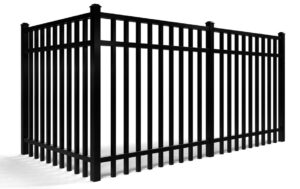
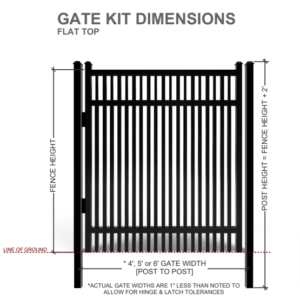 At Fence Workshop™, we specialize in selling top-quality aluminum fence kits to residential customers and DIY enthusiasts. Our aluminum fencing is designed to offer a combination of elegance, durability, and low-maintenance performance, making it an excellent choice for homeowners looking to enhance the security and curb appeal of their property. With a wide range of styles, heights, and finishes available, our aluminum fence kits provide the perfect solution for any outdoor space.
At Fence Workshop™, we specialize in selling top-quality aluminum fence kits to residential customers and DIY enthusiasts. Our aluminum fencing is designed to offer a combination of elegance, durability, and low-maintenance performance, making it an excellent choice for homeowners looking to enhance the security and curb appeal of their property. With a wide range of styles, heights, and finishes available, our aluminum fence kits provide the perfect solution for any outdoor space.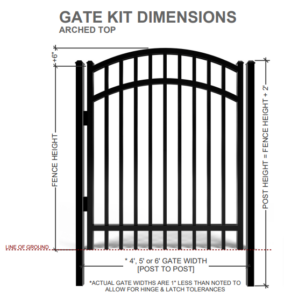 Choosing a DIY aluminum fence kit from Fence Workshop™ offers numerous advantages, including:
Choosing a DIY aluminum fence kit from Fence Workshop™ offers numerous advantages, including: At Fence Workshop™, we offer premium
At Fence Workshop™, we offer premium 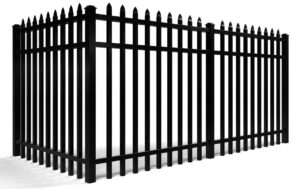 Fence Workshop™ is known for its commitment to quality and customer satisfaction. When you choose one of our fence kits, you’re getting more than just materials—you’re getting expert support and a product designed to exceed your expectations. Our fence kits are trusted by DIYers and contractors throughout the region, and we’re proud to offer kits that are easy to install and made to last.
Fence Workshop™ is known for its commitment to quality and customer satisfaction. When you choose one of our fence kits, you’re getting more than just materials—you’re getting expert support and a product designed to exceed your expectations. Our fence kits are trusted by DIYers and contractors throughout the region, and we’re proud to offer kits that are easy to install and made to last.